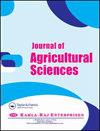不同葡萄品种和不同家庭采收的哈达利叶饮料的理化、功能和微生物特性
IF 0.7
Q3 AGRICULTURE, MULTIDISCIPLINARY
引用次数: 5
摘要
从土耳其Kirklareli市的不同地区采集了23份hardaliye饮料样品,并根据传统方法在实验室条件下制作了5份hardaliye样品。测定了总酚类化合物、单体花青素(malvidin-3-glucoside)、挥发性酸、乙醇、总糖含量、总酸度(乳酸)、pH、颜色值(L(亮度)、a(红绿)、b(黄蓝))、总嗜酸性好氧细菌、乳酸菌、酵母和霉菌以及大菌群计数。酸度为0.38 ~ 0.91%,pH为3.54 ~ 4.33,色度(l.a.b.)值为7.57 ~ 13.74,0.71 ~ 7.68,0.73 ~ 4.50。23个样本中有7个样本的总酚含量在368.8 ~ 2647.5 mg L-1之间,乙醇含量在0.4 ~ 6.0%之间,23个样本中有16个样本的TMAB数为3x1013.2x106 cfu mL-1, LAB数为1x102-3x105 cfu mL-1, 23个样本中有18个样本的酵母和霉菌数为1x101-2,3x104 cfu mL-1。结果显示,分析样品中未发现大肠菌群和大肠杆菌。统计分析结果显示,样品间差异有统计学意义(P≤0.01)。鉴于其生物活性特性,硬化剂饮料应大规模生产,并得到广大社区的认可。本文章由计算机程序翻译,如有差异,请以英文原文为准。
Physicochemical, Functional and Microbiological Properties of Hardaliye Beverages Produced from Different Grapes and Collected from Different Households
Twenty-three hardaliye beverage samples were collected from different regions of Kirklareli city in Turkey and five hardaliye samples were produced under laboratory conditions according to traditional methods. Total phenolic compounds, monomeric anthocyanins (malvidin-3-glucoside), volatile acid, ethyl alcohol, total sugar contents, total acidity (lactic acid), pH, color values (L (brightness), a (red-green), b (yellow-blue)), total mesophilic aerobic bacteria, lactic acid bacteria, yeast and mold and coliform counts were determined. Acidity between 0.38 and 0.91%, pH from 3.54 and 4.33, color (L.a.b.) values from 7.57 to 13.74, from 0.71 to 7.68, from 0.73 to 4.50, respectively were determined. Total phenolics from 368.8 to 2647.5 mg L-1, ethanol between 0.4 and 6.0% in 7 out of 23 examples, TMAB number 3x1013.2x106 cfu mL-1, LAB 1x102-3x105 cfu mL-1 in 16 out of 23 samples, yeast and mold count 1x101-2,3x104 cfu mL-1 in 18 out of 23 samples were found. According to the results obtained, coliforms and Escherichia coli were not found in the analyzed samples. Statistical analysis results revealed that differences between samples were significant (P≤0.01). Given its bioactive characteristics, hardaliye beverage should be produced at large-scale and be recognized by large communities.
求助全文
通过发布文献求助,成功后即可免费获取论文全文。
去求助
来源期刊

Journal of Agricultural Sciences
AGRICULTURE, MULTIDISCIPLINARY-
CiteScore
1.80
自引率
0.00%
发文量
0
 求助内容:
求助内容: 应助结果提醒方式:
应助结果提醒方式:


